Related Research Articles

The history of Saudi Arabia in its current form as a nation state began with the emergence of the Al Saud dynasty in central Arabia in 1744 and the subsequent establishment of the Emirate of Diriyah. The territory that now constitutes Saudi Arabia was the site of several ancient cultures and civilizations. The prehistory of Saudi Arabia shows some of the earliest traces of human activity in the world. The world's second-largest religion, Islam, emerged in modern-day Saudi Arabia. In the early 7th century, the Islamic prophet Muhammad united the population of Arabia and created a single Islamic religious polity. Following his death in 632, his followers rapidly expanded the territory under Muslim rule beyond Arabia, conquering huge and unprecedented swathes of territory in a matter of decades. Arab dynasties originating from modern-day Saudi Arabia founded the Rashidun (632–661), Umayyad (661–750), Abbasid (750–1517) and Fatimid (909–1171) caliphates as well as numerous other dynasties in Asia, Africa and Europe.

Riyadh is the capital of Saudi Arabia and the largest city on the Arabian Peninsula. Located in the center of the an-Nafud desert, on the eastern part of the Najd plateau, the city sits at an average of 600 meters (2,000 ft) above sea level, and receives around 5 million tourists each year, making it the forty-ninth most visited city in the world and the 6th in the Middle East. Riyadh had a population of 7.6 million people in 2019, making it the most-populous city in Saudi Arabia, 3rd most populous in the Middle East, and 38th most populous in Asia.
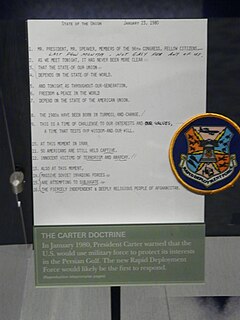
The Carter Doctrine was a policy proclaimed by President of the United States Jimmy Carter in his State of the Union Address on January 23, 1980, which stated that the United States would use military force, if necessary, to defend its national interests in the Persian Gulf. It was a response to the Soviet Union's intervention in Afghanistan in 1979, and it was intended to deter the Soviet Union, the United States' Cold War adversary, from seeking hegemony in the Persian Gulf region.
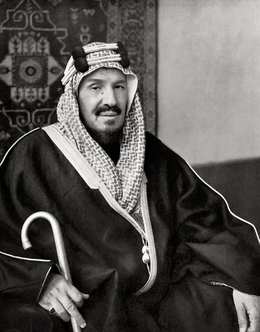
Abdulaziz bin Abdul Rahman Al Saud, known in the West as Ibn Saud, was an Arab tribal leader and statesman who founded Saudi Arabia, the third Saudi state. He was King of Saudi Arabia from 23 September 1932 to his death in 1953. He had ruled parts of the kingdom since 1902, having previously been Emir, Sultan, and King of Nejd, and King of Hejaz.
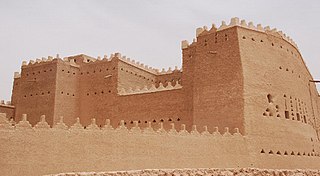
Diriyah, formerly romanized as Dereyeh and Dariyya, is a town in Saudi Arabia located on the north-western outskirts of the Saudi capital, Riyadh. Diriyah was the original home of the Saudi royal family, and served as the capital of the Emirate of Diriyah under the first Saudi dynasty from 1744 to 1818. Today, the town is the seat of the Diriyah Governorate, which also includes the villages of Uyayna, Jubayla, and Al-Ammariyyah, among others, and is part of Ar Riyad Province.

USS Quincy (CA-71) was a heavy cruiser of the Baltimore-class of the United States Navy. She was the third ship to carry the name.

The Great Bitter Lake is a large saltwater lake in Egypt that is part of the Suez Canal. Before the canal was built in 1869, the Great Bitter Lake was a dry salt valley or basin. References are made to the Great Bitter Lake in the ancient Pyramid Texts.
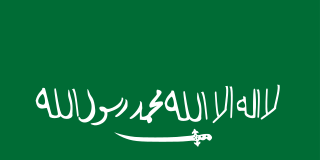
The Ikhwan, also Akhwan, was the first Saudi army made up of traditionally nomadic tribesmen which formed a significant military force of the ruler Ibn Saud and played an important role in establishing him as ruler of most of the Arabian Peninsula in the Kingdom of Saudi Arabia. The Ikhwan later became the Saudi Arabian National Guard.
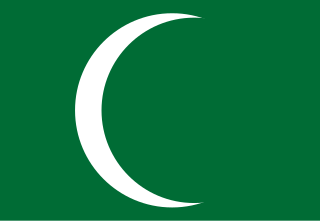
The Emirate of Nejd or Imamate of Nejd was the Second Saudi State, existing between 1824 and 1891 in Nejd, the regions of Riyadh and Ha'il of what is now Saudi Arabia. Saudi rule was restored to central and eastern Arabia after the Emirate of Diriyah, the First Saudi State, having previously been brought down by the Ottoman Empire's Egypt Eyalet in the Ottoman–Wahhabi War (1811–1818).

USS Murphy (DD-603) was a Benson-class destroyer in the United States Navy during World War II. She was named for Lieutenant John McLeod Murphy.

The Masmak Fort, also called the Masmak Fortress or Masmak Palace, is a clay and mudbrick fort in ad-Dirah, Riyadh, Saudi Arabia. Built in 1865 for prince 'Abdurrahman ibn Sulaiman AlDabaan under the Emirate of Jabal Shammar, The fortress played an integral role in the Unification of Saudi Arabia, with the Battle of Riyadh, one of the most important conflicts of the Saudi unification, taking place in the fort. Since 1995, the fortress has been converted into a museum showcasing one of the most important landmarks of Saudi heritage.
Al-Ajman or al-'Ijman is an Arabian tribal confederation in the Arabian Peninsula, with Ajman spread across Saudi Arabia, Qatar, U.A.E. and the Kuwait.

The Unification of Saudi Arabia was a military and political campaign in which the various tribes, sheikhdoms, city-states, emirates, and kingdoms of most of the Arabian Peninsula were conquered by the House of Saud, or Al Saud. Unification started in 1902 and continued until 1932, when the Kingdom of Saudi Arabia was proclaimed under the leadership of King Abdulaziz, creating what is sometimes referred to as the Third Saudi State, to differentiate it from the Emirate of Diriyah, the First Saudi State and the Emirate of Nejd, the Second Saudi State, also House of Saud states.

The Battle of Riyadh was a minor battle of the Unification War between Rashidi and Saudi rebels. It occurred on 13 January 1902, in Masmak Castle in Riyadh, the capital of present-day Saudi Arabia.

William Alfred "Bill" Eddy, Ph.D., Col., USMC was a U.S. minister to Saudi Arabia (1944–1946); university professor and college president (1936–1942); U.S. Marine Corps officer, serving in World War I and World War II; and U.S. intelligence officer.

The Ikhwan Revolt began in 1927, when the tribesmen of the Otaibah and Mutayr and Ajman rebelled against the authority of Ibn Saud and engaged in cross-border raids into parts of Trans-Jordan, Mandatory Iraq and the Emirate of Kuwait. The relationship between the House of Saud and the Ikhwan deteriorated into an open bloody feud in December 1928. The main instigators of the rebellion were defeated in the Battle of Sabilla, on 29 March 1929. Ikhwan tribesmen and troops loyal to Abdulaziz clashed again in the Jabal Shammar region in August 1929, and Ikhwan tribesmen attacked the Awazim tribe on 5 October 1929. Faisal Al Dawish, the main leader of the rebellion and the Mutair tribe, fled to Kuwait in October 1929 before being detained by the British and handed over to Ibn Saud. Faisal Al-Dawish would die in Riyadh on 3 October 1931 from what appears to have been a heart condition. Government troops had finally suppressed the rebellion on 10 January 1930, when other Ikhwan rebel leaders surrendered to the British. In the aftermath, the Ikhwan leadership was slain, and the remains were eventually incorporated into regular Saudi units. Sultan bin Bajad, one of the three main Ikhwan leaders, was killed in 1931, while Al Dawish died in prison in Riyadh on 3 October 1931.

Az Zulfi is a city in Riyadh Province in central Saudi Arabia, about 260 kilometres northwest of Riyadh. It is connected by Roads 418 and 535 which both link with the main Highway 65 which connects Riyadh to Buraidah which is about 101 kilometres by road to west of Al Zulfi. Zulfi also forms a governorate of Riyadh Province. The Al-Yamama/Tuwaiq mountain range begins in the desert to the north of Al Zulfi.

Mansour bin Abdulaziz Al Saud was a member of the House of Saud who served as the defense minister of Saudi Arabia between 1943 and 1951. During his adulthood Prince Mansour was the third most powerful son of King Abdulaziz after Prince Faisal and Crown Prince Saud.
The following is a Gregorian timeline of the history for the city of Riyadh, Saudi Arabia.
References
- ↑ Video of meeting between Roosevelt and Ibn Saud (Archive (3/25/2011))
- ↑ Photo of the historic meeting between Roosevelt and ibn Saud
- ↑ Interview with Amb. Bob Jordan, 2002 Archived March 10, 2005, at the Wayback Machine
- ↑ Remarks by Amb. James C. Oberwetter, 15 February 2005 Archived September 28, 2007, at the Wayback Machine